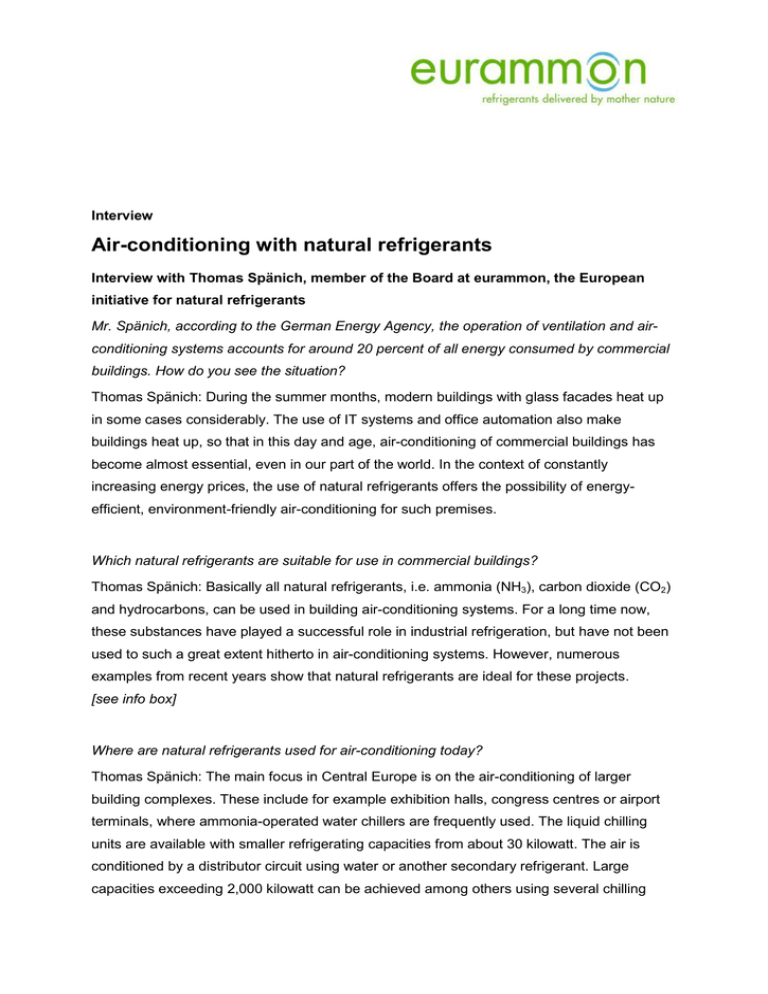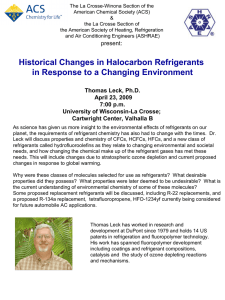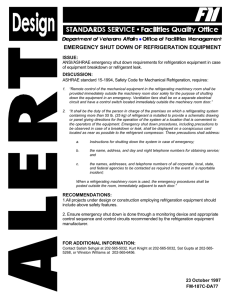Air-conditioning with natural refrigerants
advertisement

Interview Air-conditioning with natural refrigerants Interview with Thomas Spänich, member of the Board at eurammon, the European initiative for natural refrigerants Mr. Spänich, according to the German Energy Agency, the operation of ventilation and airconditioning systems accounts for around 20 percent of all energy consumed by commercial buildings. How do you see the situation? Thomas Spänich: During the summer months, modern buildings with glass facades heat up in some cases considerably. The use of IT systems and office automation also make buildings heat up, so that in this day and age, air-conditioning of commercial buildings has become almost essential, even in our part of the world. In the context of constantly increasing energy prices, the use of natural refrigerants offers the possibility of energyefficient, environment-friendly air-conditioning for such premises. Which natural refrigerants are suitable for use in commercial buildings? Thomas Spänich: Basically all natural refrigerants, i.e. ammonia (NH3), carbon dioxide (CO2) and hydrocarbons, can be used in building air-conditioning systems. For a long time now, these substances have played a successful role in industrial refrigeration, but have not been used to such a great extent hitherto in air-conditioning systems. However, numerous examples from recent years show that natural refrigerants are ideal for these projects. [see info box] Where are natural refrigerants used for air-conditioning today? Thomas Spänich: The main focus in Central Europe is on the air-conditioning of larger building complexes. These include for example exhibition halls, congress centres or airport terminals, where ammonia-operated water chillers are frequently used. The liquid chilling units are available with smaller refrigerating capacities from about 30 kilowatt. The air is conditioned by a distributor circuit using water or another secondary refrigerant. Large capacities exceeding 2,000 kilowatt can be achieved among others using several chilling units equipped with screw compressors. For example, ammonia chillers have been used since 2004 for the air-conditioning in Terminal 3 of Stuttgart airport. What is the situation with smaller capacity ranges? Thomas Spänich: Ammonia and CO2 are best suited to these applications which are used among others for office air-conditioning. However, at the moment, components for systems with smaller capacity are still being produced in relatively small quantities which makes them about 20 percent more expensive than systems with synthetic refrigerants. On the other hand, the higher costs are offset by good energy efficiency, so that as a rule, the additional costs can be recovered within about two to three years. Hydrocarbons can also be used as refrigerants in company IT and server rooms. Greenpeace's IT and office rooms in Vienna for example are cooled with propane. Statutory filling restrictions apply to hydrocarbons on account of their flammability, so that up to now it has only been possible to use them on a smaller scale. However, it would be better if the restriction were made dependent on the conditions prevailing in each particular case, allowing larger filling quantities for example if a system is erected outside a building. CO2 has not been used for very long in air-conditioning. Can you tell us why? Thomas Spänich: For a long time it was not possible to use CO2 in air-conditioning because the components, which have to be rated for the higher pressures in operation with carbon dioxide, were simply not available. Moreover, CO2 solutions were deemed to be less energyefficient than applications with synthetic refrigerants. Meanwhile, economical solutions are now also available for office buildings with capacities between 50 and 340 kilowatt. Carbon dioxide is used for example to cool the computing centre at the ABM Amro Bank in London. In the long term, carbon dioxide will see increasing use in systems with smaller capacities of up to 500 kilowatt. CO2 is not flammable and is chemically inactive, giving it the broadest acceptance in the general public of all natural alternatives in unsupervised small and mini systems. But further development work is necessary here, as at present no suppliers manufacture the components in larger quantities, which would generate competitive prices. Research is currently also looking increasingly at the use of CO2 in heat pumps: the corresponding results could also be significant for future air-conditioning solutions. Mr. Spänich, eurammon has been advocating the use of natural refrigerants for 15 years now. Which particular advantages do they offer? Thomas Spänich: On the one hand, natural refrigerants are inexpensive, readily available raw materials. The differences in price to synthetic refrigerants already make themselves felt for example when filling a system for the first time, and also particularly where leakage losses are concerned. Furthermore, natural refrigerants are extremely energy-efficient. Ammonia as refrigerant has verifiably the best thermodynamic properties and needs only relatively little effort to generate refrigerating capacity. While the efficiency of an airconditioning system depends more on its overall concept than on the particular refrigerant being used, a number of current projects indicate that systems are particularly efficient and environmentally friendly when operating with natural refrigerants. In addition, natural refrigerants do not contribute to depleting the ozone layer and have no or only negligible influence on the greenhouse effect. They are therefore absolutely unrivalled in terms of the climate. What has to happen to make sure that natural refrigerants are used more frequently in airconditioning systems in future? Thomas Spänich: While the use of applications with natural refrigerants is on the increase, these systems are still not self-evident. Already the planning and also the implementation, operation and maintenance of air-conditioning systems using natural refrigerants must be accompanied by an intensified exchange of knowledge about the properties and possible uses of natural refrigerants and the handling of their corresponding systems. This also includes bringing technological know-how in the form of example projects to less developed countries where natural refrigerants have scarcely been used up to now. Do you see any applications with natural refrigerants as playing a particularly seminal role in future? Thomas Spänich: Heat pump applications with natural refrigerants are particularly in trend, with heating systems making further use of the waste heat produced by industrial refrigeration systems and computing centres or the purified wastewater from sewage treatment plants. Little energy is consumed by the actual heating-up process on account of the heat that is already available. It is meanwhile possible to reach temperatures of up to 80°C in this way. This technology has also been discovered by larger energy companies that use large-scale heat pumps to supply whole urban districts with hot water. <<Info box >> Environment-friendly and energy efficient Numerous application examples illustrate the long-standing, successful use of natural refrigerants in air-conditioning 1998 KWN Engineering plans the air-conditioning of office and IT rooms for Greenpeace headquarters in Vienna. The concept features an indirect refrigeration system using the natural refrigerant propane with a liquid chilling unit and a capacity of 30 kilowatt. 1999 Johnson Controls (formerly York) develops an ammonia system for air-conditioning the office rooms at Saab in Linköping, Sweden. Here the system required for efficient supply of refrigeration for the premises covering 5,000 square metres also needed to be easily upgradable to cope with future expansion. The solution comprised a central plant for remote air-conditioning, consisting of four ammonia liquid chilling units with a refrigerating capacity of two megawatt each. An extensive piping network provides the administration buildings with refrigeration consisting of water at a temperature of 8 to 16°C (summer) respectively 12 to 16°C (winter), keeping the temperature in all rooms at a pleasant 20 to 23°C, regardless of the time of year. 2000 Frigopol installs an air-conditioning system using the natural refrigerant R723 (ammonia / dimethyl ether) in its office building. The core element of the refrigerating system that operates with a blend of natural refrigerants is a two-circuit liquid chilling unit. The refrigerating capacity is around 60 kilowatt with an evaporation temperature of 0°C and a condensation temperature of 45°C. The system comprises two separating hood compressors each with a plate heat exchanger, together with an air-cooled condenser. The structure of the installation corresponds essentially to a conventional HFC refrigeration system. 2000 Berlin's Ostbahnhof train station is equipped by Grasso with a system for the airconditioning and ventilation of the three-storey building complex. The necessary airconditioning and ventilation tasks in the buildings entail cooling the secondary refrigerant down from 16 to 10°C. The solution consists of three air-cooled ammonia compact liquid chilling units with a total capacity of 1,250 kilowatt. 2004 Stuttgart airport changes over to ammonia. Grasso installs an ammonia system for the new Terminal 3, comprising two liquid chilling units with an overall capacity of 2,300 kilowatt. The system was designed to work both in ice bank operation and, together with the already installed refrigeration circuits, in a combined hydraulic system, so that maximum efficiency is always warranted even in low-load mode. 2005 Ammonia air-conditioning system installed for 22,000 square metres of working areas at Roche's headquarters in Welwyn Garden City near London. Star Refrigeration installed two ammonia chiller units with 930 kilowatt capacity each on the roof of the building. In this way, the condensers are chilled by the outside temperature, thus further increasing the efficiency of the system. Three units operating with hydrocarbons are used just for chilling the server rooms, with a refrigerating capacity of 130 kilowatt each. 2006 The London branch of the Dutch ABN Amro Bank chills its computing centre with a two-stage CO2 refrigerating system by Star Refrigeration. The chilling system has a capacity of altogether 300 kilowatt. The carbon dioxide is condensed with water at 6°C via an indirect chilling circuit. The centre is cooled by fans at the back of the server cabinets where the carbon dioxide evaporates at 14°C, absorbing the heat sucked in by the fans. 2008 Mülligen letter sorting centre, which is the largest building in Switzerland, is provided with refrigeration and heat by an ammonia heat pump from Johnson Controls. The energy needed for heating and chilling is taken from the wastewater of a nearby sewage plant. The heat pump has a refrigerating capacity of 4.3 and a heating capacity of 5.6 megawatt at 62°C outlet temperature. Refrigeration is generated in the first stage by three Sabroe piston compressors at an evaporation temperature of 5°C and a condensation temperature of 30°C. In heat pump mode, five Sabroe high-pressure piston compressors compress the ammonia and generate a temperature of 65°C. The highpressure liquid is supercooled and expanded in two stages via the intermediate pressure vessel. 2010 Johnson Controls develops an integrated refrigeration and air-conditioning concept for the Ozeaneum in Stralsund with a total refrigerating capacity of 900 kilowatt, including around 500 kilowatt for air-conditioning. A single-stage ammonia refrigeration system was installed with flooded evaporation, consisting of two separated Chill-Pac chilling units with 730 kilowatt each and two hybrid evaporative condensers for chilling cold water. Direct condensation is provided by two Jäggi hybrid chillers installed on the roof with a capacity of 850 kilowatt each. The required total refrigerating capacity of 900 kilowatt is already achieved with the two Chill-Pac units working at 60%, thus considerably reducing the operating noise level of the system. More case examples at www.eurammon.com Annex Ammonia (NH3) Ammonia has been successfully used as a refrigerant in industrial refrigeration plants for over 100 years. It is a colourless gas, liquefies under pressure, and has a pungent odour. In coolant technology, ammonia is known as R 717 (R = Refrigerant) and is synthetically produced for use in refrigeration. Ammonia has no ozone depletion potential (ODP = 0) and no direct global warming potential (GWP = 0). Thanks to its high energy efficiency, its contribution to the indirect global warming potential is also low. Ammonia is flammable. However, its ignition energy is 50 times higher than that of natural gas and ammonia will not burn without a supporting flame. Due to the high affinity of ammonia for atmospheric humidity it is rated as “hardly flammable”. Ammonia is toxic, but has a characteristic, sharp smell which gives a warning below concentrations of 3 mg/m³ ammonia in air possible. This means that ammonia is evident at levels far below those which endanger health (>1,750 mg/m³). Furthermore ammonia is lighter than air and therefore rises quickly. Carbon dioxide (CO2) Carbon dioxide is known in refrigeration technology as R 744 and has a long history extending back to the mid 19th century. It is a colourless gas that liquefies under pressure, with a slightly acidic odour and taste. Carbon dioxide has no ozone depletion potential (ODP = 0) and negligible direct global warming potential (GWP = 1) when used as a refrigerant in closed cycles. It is non-flammable, chemically inert and heavier than air. Carbon dioxide has a narcotic and asphyxiating effect only in high concentrations. Carbon dioxide occurs naturally in abundance. Hydrocarbons Refrigeration plants using hydrocarbons such as propane (R 290, C3H8), propene (R 1270, C3H6) or isobutane (R 600a, C4H10) have been in operation all over the world for many years. Hydrocarbons are colourless and nearly odourless gases that liquefy under pressure, and have neither ozone depletion potential (ODP = 0) nor significant direct global warming potential (GWP = 3). Thanks to their outstanding thermodynamic characteristics, hydrocarbons make particularly energy efficient refrigerants. Hydrocarbons are flammable, however, with currently available safety devices, refrigerant losses are near zero. Hydrocarbons are available at low cost all over the world; thanks to their ideal refrigerant characteristics they are commonly used in small plants with low refrigerant charges. Ozone Depletion and Global Warming Potential of Refrigerants Ozone Depletion Potential Global Warming (ODP) Potential (GWP) Ammonia (NH3) 0 0 Carbon dioxide (CO2) 0 1 Hydrocarbons (propane C3H8, propene C3H6, isobutane C4H10) 0 <3 Water (H2O) 0 0 Chlorofluoro-hydrocarbons (CFCs) 1 4680–10720 Partially halogenated chlorofluorohydrocarbons (HCFCs) Per-fluorocarbons (PFCs) 0.02–0.06 76–12100 0 5820–12010 Partially halogenated fluorinated 0 122–14310 hydrocarbons (HFCs) Ozone Depletion Potential (ODP) The ozone layer is damaged by the catalytic action of chlorine, fluorine and bromine in compounds, which reduce ozone to oxygen and thus destroy the ozone layer. The Ozone Depletion Potential (ODP) of a compound is shown as chlorine equivalent (ODP of a chlorine molecule = 1). Global Warming Potential (GWP) The greenhouse effect arises from the capacity of materials in the atmosphere to reflect the heat emitted by the Earth back onto the Earth. The direct Global Warming Potential (GWP) of a compound is shown as a CO2 equivalent (GWP of a CO2 molecule = 1). <<Infobox>> About Thomas Spänich Thomas Spänich, born in 1964, became a member of the eurammon executive board in 2004. The refrigeration engineer is manager for customized systems for engineering and sales at GEA Grasso GmbH, Berlin. Spänich studied thermal and hydraulic mechanical engineering at the Technical University of Dresden and obtained his degree in refrigeration technology in 1990. He began his professional career that same year as a development engineer with Kühlautomat Berlin GmbH. He has worked as a product manager for chillers with Grasso GmbH Refrigeration Technology since 1997 and in addition has supervised the marketing department since 2004. About eurammon eurammon is a joint European initiative of companies, institutions and individuals who advocate an increased use of natural refrigerants. As a knowledge pool for the use of natural refrigerants in refrigeration engineering, the initiative sees as its mandate the creation of a platform for information sharing and the promotion of public awareness and acceptance of natural refrigerants. The objective is to promote the use of natural refrigerants in the interest of a healthy environment, and thereby encourage a sustainable approach in refrigeration engineering. eurammon provides comprehensive information about all aspects of natural refrigerants to experts, politicians and the public at large. It serves as a qualified contact for anyone interested in the subject. Users and designers of refrigeration projects can turn to eurammon for specific project experience and extensive information, as well as for advice on all matters of planning, licensing and operating refrigeration plants. The initiative was set up in 1996 and is open to European companies and institutions with a vested interest in natural refrigerants, as well as to individuals e.g. scientists and researchers. Internet URL: www.eurammon.com Contacts eurammon contact eurammon Dr. Karin Jahn Lyoner Strasse 18 D-60528 Frankfurt Germany Phone: +49 (0)69 6603-1277 Fax: +49 (0)69 6603-2276 E-mail: karin.jahn@eurammon.com Press contact FAKTOR 3 AG Anika Hagemeier Kattunbleiche 35 D-22041 Hamburg Germany Phone: +49 (0)40 679446-34 Fax: +49 (0)40 679446-11 E-mail: eurammon@faktor3.de





